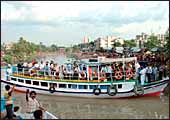 |
| The Bengal connection: With ministers,
bureaucrats and journalists on board, MV Durga reaches Baghbazar |
AUGUST
8, 2006, 3.30 P.M.
Chitpur Lock Gate, Kolkata
MV
Durga and MV Niharika have been specially decorated for the occasion.
Each can accommodate 40 people, and over the next hour, the two
together will play host to a group of 70 ministers, bureaucrats,
and journalists, together clubbed under the VIP-tag (Very Important
Person) popular in the country. There are Bengal's famed sweetmeats,
cakes and pastries in varied hues, and non-alcoholic beverages.
The occasion itself is the first act of what is often called West
Bengal Chief Minister Buddhadeb Bhattacharjee's Venice Dream,
a project that seeks to use the 43-km long canal between Chitpur,
adjoining the Cossipore terminal on the eastern bank of the Hoogly,
and Kultigang where the water body meets the Bidyadhari. The canal
passes through Baghbazar, Shyambazar, VIP Road, Salt Lake, the
new township at Rajarhat, and the trading post at Bhangore. The
distance between Chitpur to the beginning of the Raimangal, the
point of entry into Bangladesh's river system, is a mere 90-km,
through the canal and the Bidyadhari; the current route is around
275-km, down the Hoogly, and past the mangrove forests of the
Sunderbans.
Bhattacharjee is aware of this fact, and
the commercial benefits of knocking 185-km off a popular route.
He also has ambitious plans of beautifying both banks of the canals:
children's parks, flower gardens, cafes, he has thought of them
all. Thirty minutes into a largely uneventful journey on the placid
waters of the canal, we come across a model garden at Ultadanga.
This, we are told, is how, the entire stretch will look. Ultadanga
also marks the end of our journey; we are to turn back here for
Chitpur Lock; it will take a while for the second stage of the
canal, between Ultadanga and Kultigang to be ready for traffic.
It seems somehow apt that the two cities
that were once the capital of British India, Chennai (formerly
Madras) and Kolkata (Calcutta) boast waterways that were once
popular means of inland transportation. The UK itself is renowned
for its system of canals that traverse almost the entire country
and which it has used to good effect to attract tourists. Since
independence, however, the inland waterways in the two cities
have suffered. Chennai's Buckingham Canal, once a water body that
was more than 400 km long and extended from Chennai to Marakkanam,
near Pondicherry on the South and Pedaganjam in Andhra Pradesh
to the North, was built by the British to ship goods in and out
of Chennai but has since fallen into disrepair (it hasn't been
used for transport purposes since the early 1970s). There has
been talk of reviving the canal and using it for commercial purposes,
just as there has been talk of developing the two banks into entertainment
zones replete with food courts, amusement parks, gardens, and
children's parks.
 |
| Here lies the catch: MV Durga gets stuck
in the mud at Ultadanga. MV Niharika meets with the same fate.
(bottom) The locals on either side of the canal enjoy every
bit of the drama |
 |
Kolkata's canal network, too, hasn't been
used since the early 1970s. Until then, it was used to ferry passengers
and cargo from Kolkata to Dibrugarh through what was then East
Pakistan. There was even a regular biweekly steamer service. Raw
jute and fresh produce was shipped into Kolkata from adjoining
areas, and build materials shipped out. Since then, however, encroachments
on the urban stretches of the banks, pollution, and lack of maintenance
have combined to render the network unusable.
The dream of restoring the canals and using
them for transportation has never really gone away in the two
cities. Neither boasts a road network that can be compared to
Delhi's, even after factoring in their smaller size; and neither
has a railway network as extensive as Mumbai's. Then, there's
the promise of parks, gardens, and play areas, all very alluring.
Bhattacharjee's Venice obsession is entirely understandable.
At Ultadanga, the launches turn back and
Bhattacharjee's plans run aground (at least temporarily). MV Durga,
ferrying ministers and bureaucrats (including Housing Minister
and Housing and Infrastructure Development Corporation Chairman
Goutam Deb, Irrigation Minister Subhash Naskar, Chief Secretary
Amit Kiran Deb, and Transport Secretary Sumantra Chowdhury) gets
stuck in the mud while turning back. Soon, mv Niharika meets with
the same fate. The finger-pointing starts. "We are stuck
because of the low depth of the canal." "The excavation
work has not been carried our properly." "The irrigation
department is responsible for desilting." The ministers and
the bureaucrats have to bear the indignity of jumping off the
ferries. HIDCO execs explain that while the required depth to
run a ferry is eight feet, the canal is only two feet deep in
some places. Further desilting, they add, is required to keep
the project (promoted jointly by hidco, the Irrigation Department,
the Transport Department and Kolkata Municipal Corporation), well,
afloat. "We will eventually operate passenger, cargo, and
leisure vessels from Chitpur to Kulti via Salt Lake and Rajarhat,"
stresses one functionary of the state government before leaving
the spot in a bit of a huff. A flak-catcher calls up later to
claim that the whole exercise was a "trial run" to ascertain
the "problems and difficulties". And so, India progresses
towards upgrading the transport infrastructure of its cities.
|







